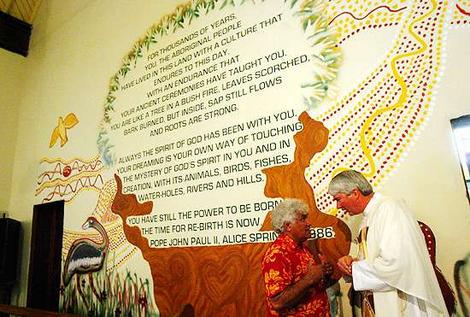|
|
ANYONE who knows St Vincent's parish in Redfern knows it is as idiosyncratic as much of the area that surrounds it. Parishioners include some of the most marginalised people in Sydney as well as some of the more well-heeled, tales of disruptions and interjections of various kinds during Mass are legendary, and over the years the unorthodox use of church property to meet local needs has put the parish on a collision course with the archdiocese. So the fact that some parishioners sneaked into the church last weekend and, without the knowledge of their priest, painted a mural on the wall is not all that unusual in the scheme of things. What has changed is the reaction to this kind of behaviour. Under the late Father Ted Kennedy, parish priest for more than 30 years, it was all part of the ebb and flow of human life which no man (and certainly no church) could ever hope fully to control. But under the present parish priest, Father Gerry Prindiville, last weekend's antics constitute vandalism and that's evidence of the tide of human sinfulness the church and its teachings are intended to hold back. What makes St Vincent's of wider interest, however, is that it seems to be a battleground for two competing models of church. One of those is the church identified with Kennedy: pastoral in its dealings with people, lay-centred in its administration, and broad and welcoming in its outreach. The other is the church identified with Prindiville, said to be dogmatic, clerically dominated and tending toward the exclusivity of a club rather than the warts-and-all inclusiveness of a community. Clearly there is some truth in this depiction. Kennedy was strongly influenced by the American Catholic Worker Movement, whose lay activist members lived with the poor and strove for social justice. Prindiville, by contrast, is a member of the Neocatechumenal Way, a conservative Catholic group of Spanish origins which emphasises making converts over changing society and promotes a disciplined spiritual regime as the answer to life's problems. From those two different perspectives, radically opposed conceptions of what it means to be a church - and thus to run a parish - can emerge. As well, Prindiville's appointment must be viewed in the wider context of Cardinal George Pell's attempts to rein in independently minded priests and their parishioners, and to reaffirm a rigid Catholic orthodoxy throughout the Sydney Archdiocese. Pell has done this, in part, by providing beachheads in Sydney to conservative groups such as Opus Dei and the Neocatechumenal Way. St Vincent's is the most outstanding example of how this approach can backfire, and the Cardinal must take ultimate responsibility for it by having parachuted in a complete outsider - Prindiville comes from Perth and had no experience with urban Aborigines - as though Redfern is a foreign missionary post. But those who want to promote the notion that St Vincent's is some kind of testing ground are unlikely to ever prove much of a point. For one thing, it is clearly not just different models of church that are in conflict there but also - and more so - the very different personalities of its priests. For another, the very idiosyncrasy of St Vincent's is likely to render moot any more general conclusions about what happens there. There are other reasons why a simplistic approach to events in St Vincent's is deceptive. Most important of these is the fact that Kennedy struggled, as much as Prindiville is now struggling, with outmoded parish structures and cultures. Kennedy responded by including everyone; Prindiville seems only to want those who will respect the church and its teachings. Neither solution offers a practical - much less satisfying - answer to the question of what constitutes Catholic identity. Kennedy's approach also achieved little judged by the reality that nothing much has changed for the better among his "parishioners". Indeed, his having virtually been canonised by those who knew, and deservedly, loved him may prove ironic if it means the energy that could have gone into people changing their lives is now expended in venerating the memory of his. For his part, Prindiville has his own inconsistencies to contend with. The problem in St Vincent's, he said in response to the mural, "is that people won't accept any sort of authority". That's an odd statement to make when the illicit mural consisted of a statement made by the late Pope John Paul II on a visit to Alice Springs in 1986. And it raises all sorts of questions about just who or what church conservatives regard as constituting "authority" these days. Chris McGillion, an academic at Charles Sturt University, edited A Long Way from Rome: Why the Catholic Church Is in Crisis (Allen & Unwin). |
